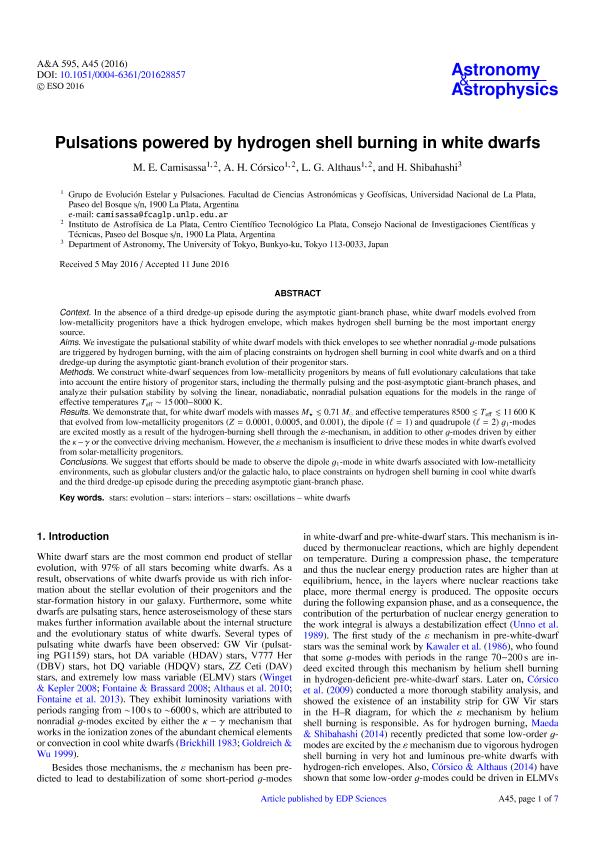Mostrar el registro sencillo del ítem
dc.contributor.author
Camisassa, María Eugenia

dc.contributor.author
Corsico, Alejandro Hugo

dc.contributor.author
Althaus, Leandro Gabriel

dc.contributor.author
Shibahashi, H.
dc.date.available
2018-02-19T16:09:56Z
dc.date.issued
2016-10
dc.identifier.citation
Camisassa, María Eugenia; Corsico, Alejandro Hugo; Althaus, Leandro Gabriel; Shibahashi, H.; Pulsations powered by hydrogen shell burning in white dwarfs; EDP Sciences; Astronomy and Astrophysics; 595; A45; 10-2016
dc.identifier.issn
0004-6361
dc.identifier.uri
http://hdl.handle.net/11336/36715
dc.description.abstract
Context. In the absence of a third dredge-up episode during the asymptotic giant-branch phase, white dwarf models evolved from low-metallicity progenitors have a thick hydrogen envelope, which makes hydrogen shell burning be the most important energy source. Aims: We investigate the pulsational stability of white dwarf models with thick envelopes to see whether nonradial g-mode pulsations are triggered by hydrogen burning, with the aim of placing constraints on hydrogen shell burning in cool white dwarfs and on a third dredge-up during the asymptotic giant-branch evolution of their progenitor stars. Methods: We construct white-dwarf sequences from low-metallicity progenitors by means of full evolutionary calculations that take into account the entire history of progenitor stars, including the thermally pulsing and the post-asymptotic giant-branch phases, and analyze their pulsation stability by solving the linear, nonadiabatic, nonradial pulsation equations for the models in the range of effective temperatures Teff 15 000-8000 K. Results: We demonstrate that, for white dwarf models with masses M⋆ ≲ 0.71 M⊙ and effective temperatures 8500 ≲ Teff ≲ 11 600 K that evolved from low-metallicity progenitors (Z = 0.0001, 0.0005, and 0.001), the dipole (ℓ = 1) and quadrupole (ℓ = 2) g1-modes are excited mostly as a result of the hydrogen-burning shell through the ɛ-mechanism, in addition to other g-modes driven by either the κ - γ or the convective driving mechanism. However, the ɛ mechanism is insufficient to drive these modes in white dwarfs evolved from solar-metallicity progenitors. Conclusions: We suggest that efforts should be made to observe the dipole g1-mode in white dwarfs associated with low-metallicity environments, such as globular clusters and/or the galactic halo, to place constraints on hydrogen shell burning in cool white dwarfs and the third dredge-up episode during the preceding asymptotic giant-branch phase.
dc.format
application/pdf
dc.language.iso
eng
dc.publisher
EDP Sciences

dc.rights
info:eu-repo/semantics/openAccess
dc.rights.uri
https://creativecommons.org/licenses/by-nc-sa/2.5/ar/
dc.subject
Evolution of Stars
dc.subject
Interior Stars
dc.subject
Oscillations
dc.subject
White Dwarfs
dc.title
Pulsations powered by hydrogen shell burning in white dwarfs
dc.type
info:eu-repo/semantics/article
dc.type
info:ar-repo/semantics/artículo
dc.type
info:eu-repo/semantics/publishedVersion
dc.date.updated
2018-02-07T17:03:41Z
dc.journal.volume
595
dc.journal.number
A45
dc.journal.pais
Francia

dc.journal.ciudad
Paris
dc.description.fil
Fil: Camisassa, María Eugenia. Universidad Nacional de la Plata. Facultad de Ciencias Astronómicas y Geofísicas; Argentina. Consejo Nacional de Investigaciones Científicas y Técnicas. Centro Científico Tecnológico Conicet - La Plata. Instituto de Astrofísica La Plata. Universidad Nacional de La Plata. Facultad de Ciencias Astronómicas y Geofísicas. Instituto de Astrofísica la Plata; Argentina
dc.description.fil
Fil: Corsico, Alejandro Hugo. Consejo Nacional de Investigaciones Científicas y Técnicas. Centro Científico Tecnológico Conicet - La Plata. Instituto de Astrofísica La Plata. Universidad Nacional de La Plata. Facultad de Ciencias Astronómicas y Geofísicas. Instituto de Astrofísica la Plata; Argentina. Universidad Nacional de la Plata. Facultad de Ciencias Astronómicas y Geofísicas; Argentina
dc.description.fil
Fil: Althaus, Leandro Gabriel. Universidad Nacional de la Plata. Facultad de Ciencias Astronómicas y Geofísicas; Argentina. Consejo Nacional de Investigaciones Científicas y Técnicas. Centro Científico Tecnológico Conicet - La Plata. Instituto de Astrofísica La Plata. Universidad Nacional de La Plata. Facultad de Ciencias Astronómicas y Geofísicas. Instituto de Astrofísica la Plata; Argentina
dc.description.fil
Fil: Shibahashi, H.. University of Tokyo; Japón
dc.journal.title
Astronomy and Astrophysics

dc.relation.alternativeid
info:eu-repo/semantics/altIdentifier/doi/http://dx.doi.org/10.1051/0004-6361/201628857
dc.relation.alternativeid
info:eu-repo/semantics/altIdentifier/url/https://www.aanda.org/articles/aa/abs/2016/11/aa28857-16/aa28857-16.html
Archivos asociados
